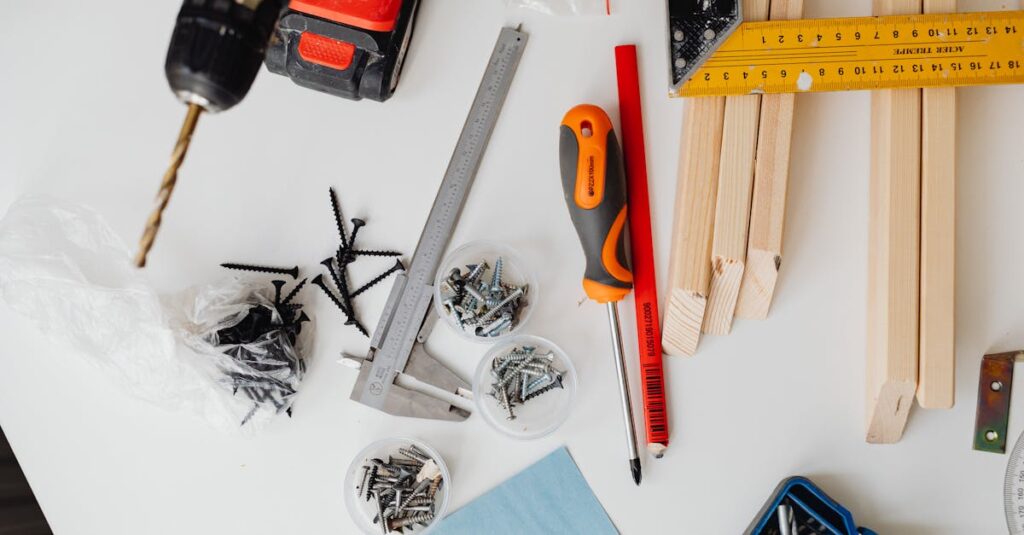Woodworking can seem daunting at first, but it’s one of the most rewarding hobbies out there. I’ve found that diving into 25 best diy woodworking projects for beginners not only sparks creativity but also builds valuable skills. Whether you’re looking to create something functional or simply want to explore your artistic side, there’s a perfect project waiting for you.
Key Takeaways
- Beginner-Friendly Projects: Start with simple projects like birdhouses, picture frames, and coffee tables to build foundational skills in woodworking.
- Skill Development: Woodworking enhances practical skills such as precision measuring, effective tool usage, and problem-solving, empowering beginners to gain confidence in their craftsmanship.
- Creativity Boost: Engaging in woodworking allows for personal expression through design and material choice, turning functional items into unique artistic pieces.
- Essential Tools: A well-equipped beginner should have basic tools like a tape measure, saw, clamps, and a cordless drill for efficient project completion.
- Planning and Safety: Effective planning, accurate measuring, and adhering to safety practices are critical for successful woodworking, reducing the risk of injury and ensuring quality work.
- Diverse Project Options: With 25 project ideas ranging from storage solutions to decorative pieces, there’s something to suit every beginner’s interests and skill level in woodworking.
25 Best DIY Woodworking Projects for Beginners
Exploring DIY woodworking projects provides an excellent opportunity for beginners to enhance their skills. These projects range from simple items like birdhouses and picture frames to more complex furniture pieces. Engaging in woodworking fosters creativity and problem-solving abilities.
Selecting the right project depends on one’s skill level and available tools. I recommend starting with manageable projects that allow for gradual learning. Here’s a breakdown of beginner-friendly woodworking projects:
- Birdhouses: Fun to build and great for outdoor aesthetics.
- Picture Frames: Versatile and customizable; also useful for home decor.
- Shelves: Essential for organization and display, and they vary in complexity.
- Coffee Tables: Practical and often simple in design, ideal for practice.
- Garden Planters: Functional for gardening enthusiasts and enhance outdoor spaces.
Embarking on these25 best diy woodworking projects for beginners yields tangible results and boosts confidence. Each project provides a chance to handle various woodworking techniques, which strengthens skills while encouraging exploration.
Benefits of Woodworking for Beginners
Woodworking offers numerous advantages for beginners, making it a fulfilling and practical hobby. Engaging with wood as a material fosters skill development and invites creativity.
Skill Development
Woodworking cultivates various hands-on skills. I learn precision through measuring and cutting wood accurately. I gain technical skills, such as using tools like saws, drills, and sanders safely and effectively. Each project contributes to my understanding of woodworking techniques, from assembling joints to finishing surfaces. Tackling diverse projects further enhances my problem-solving abilities, as I learn to troubleshoot issues that arise, ultimately building competence and confidence in my craftsmanship.
Creativity Enhancement
Woodworking serves as a powerful outlet for creativity. I explore design concepts, allowing for personal expression in each piece. Selecting materials, colors, and shapes fosters my imagination, enabling me to transform ordinary wood into unique items. Through crafting, I refine my artistic vision and develop a deeper appreciation for functional art. Each completed project reflects my personality and creativity, encouraging me to experiment with new ideas and styles. This combination of practicality and artistry enriches my woodworking experience.
Essential Tools for DIY Woodworking
Having the right tools makes woodworking projects easier and more enjoyable. Below are essential hand and power tools that every beginner should consider.
Basic Hand Tools
- Tape Measure: A crucial tool for accurate measurements, ensuring cuts fit together perfectly.
- Square: Used for marking and checking right angles, maintaining accuracy in joins and cuts.
- Saw: A hand saw or coping saw cuts through wood efficiently, offering versatility for different project types.
- Chisels: These tools refine edges and create detailed designs, essential for clean cuts and joins.
- Mallet: Used to strike chisels without damaging their edges, contributing to safe and effective chisel work.
- Clamps: Clamping pieces together during assembly stabilizes your work and ensures proper alignment.
- Screwdriver: Essential for fastening screws, a simple tool that greatly aids in project assembly.
- Pencil: Marking pieces for cutting or drilling, a simple tool that supports precision in woodworking tasks.
- Cordless Drill: A versatile tool for drilling holes and driving screws, essential for various projects.
- Jigsaw: This tool allows for intricate cuts in wood, enabling creative designs and unique shapes.
- Circular Saw: A powerful tool for straight cuts, ideal for cutting sheets of plywood or lumber quickly.
- Sander: An electric sander smooths surfaces before finishing, improving the final appearance of wood projects.
- Router: Used for hollowing out or shaping edges, offering advanced design options for projects.
- Table Saw: An investment tool for making precise cuts on larger pieces of wood, enhancing efficiency in cutting tasks.
- Band Saw: Optimal for curved cuts and resawing, this tool expands your capability in woodworking projects.
Investing in these essential tools streamlines the woodworking process, empowering beginners to create with confidence.
Woodworking Projects for Beginners
Engaging in woodworking offers numerous opportunities for beginners to develop skills while creating functional and artistic pieces. Here are 25 best diy woodworking projects for beginners to start with.
Project 1: Simple Bookshelf
Build a simple bookshelf using straight cuts for shelves and supports. Use 1×12 lumber for a sturdy design. Start by measuring the desired height and width, then cut the pieces accordingly.
Project 2: Outdoor Planter Box
Construct a durable outdoor planter box with treated lumber. Create a rectangular box by cutting four side panels and a bottom piece. Add drainage holes to the bottom for better plant health.
Project 3: Picture Frame
Craft a classic picture frame from 1×2 boards. Cut four pieces at 45-degree angles for corners, then assemble them using wood glue or nails. Sand the edges for a smooth finish and apply paint or stain.
Project 4: Beginner’s Workbench
Design a beginner’s workbench using plywood and 2x4s to provide ample workspace. Cut two side legs and connect them with horizontal supports. Ensure sufficient stability by adding a lower shelf.
Project 5: Wooden Coasters
Create a set of wooden coasters from 1×1 inch squares. Sand and finish each piece to prevent moisture damage. Personalize by using acrylic paint or wood burning techniques.
Project 6: Birdhouse
Build a functional birdhouse from plywood with a sloped roof. Cut panels for the sides, front, back, and base. Add a small entry hole and drainage holes for bird safety and comfort.
Project 7: Storage Crate
Make a storage crate using plywood or reclaimed wood for a rustic look. Cut the panels to create a box shape and use nails or screws for assembly. Finish with paint or wood stain.
Project 8: Step Stool
Assemble a step stool using 2x4s for stability. Construct two legs angled at 15 degrees for support and add a flat top. Use non-slip paint for safety when completed.
Project 9: Wall Art
Craft unique wall art by cutting geometric shapes from plywood. Arrange pieces in a visually appealing pattern and finish with paint or natural wood stain for a custom look.
Project 10: Wine Rack
Build a simple wine rack using 1×4 boards arranged at an angle. Cut and position sections to hold at least six bottles securely. Sand and stain for a polished appearance.
Project 11: Toy Chest
Construct a toy chest using plywood that features safety hinges. Create a rectangular box, ensuring the lid opens wide for easy access. Sand edges to prevent splinters.
Project 12: Coffee Table
Design a low coffee table using 2x4s for the frame and a plywood top. Build a simple rectangular shape, adding lower shelves for additional storage options.
Project 13: Garden Planter
Create a raised garden planter using 1×6 boards. Construct a rectangle with legs for height and easy access. Drill drainage holes for healthy plant growth.
Project 14: Cutting Board
Make a sturdy cutting board from hardwood like maple or walnut. Sand each piece thoroughly for a smooth surface and finish with food-safe mineral oil.
Project 15: Pet Bed
Build a custom pet bed frame using 2x4s that fits your pet’s dimensions. Add a soft cushion or blanket for comfort. Consider painting it to match your decor.
Project 16: Blanket Ladder
Construct a simple blanket ladder using 1×2 boards. Cut two upright pieces and rungs to create a lean-to style. Sand and stain for aesthetic appeal.
Project 17: Shoe Rack
Create a shoe rack using plywood for a practical storage solution. Construct a rectangular base with tiered shelves for easy organization and access.
Project 18: Phone Stand
Build a functional phone stand with minimal materials. Cut a piece of wood to a desired height, then notch it at an angle for secure phone placement during charging.
Project 19: Wall Shelf
Assemble a wall shelf using 1×2 boards to create a simple floating design. Install brackets to mount securely on the wall for storage or display purposes.
Project 20: Floating Desk
Design a floating desk with minimal materials using plywood. Cut to the preferred size and secure it to the wall with brackets. Provide adequate space for a laptop and accessories.
Project 21: Magazine Holder
Construct a magazine holder using plywood or scrap wood. Create a box shape with one open end, allowing easy access to magazines while providing a decorative touch.
Project 22: Decorative Wooden Tray
Build a decorative wooden tray using small wood pieces arranged into a rectangular shape. Sand edges and apply varnish for a polished look ideal for serving or decoration.
Project 23: Rustic Bench
Create a rustic bench using reclaimed wood for character. Cut a few planks to length for the top and legs. Ensure stability with sturdy assembly techniques.
Project 24: Small Desk Organizer
Assemble a small desk organizer using leftover wood. Cut several compartments for holding stationery items. Customize dimensions based on particular needs.
Project 25: Jewelry Box
Build a jewelry box from thin wood sheets with a lid. Cut out a simple rectangular shape and use dividers inside. Finish with decorative paint or stain for a personal touch.
Tips for Successful DIY Woodworking
Successful DIY woodworking relies on careful planning, precise measuring, and strong safety practices. Implementing these tips enhances the overall woodworking experience for beginners.
Planning and Measuring
Planning each project clearly establishes the steps to follow. Sketch designs that include dimensions, materials, and tools needed. Organize a materials list to ensure nothing is overlooked. Measuring accurately is crucial for achieving well-fitting pieces. Use a tape measure and square for precision. When cutting, always double-check measurements before making cuts. Maintaining consistency in measurement units, such as inches or centimeters, prevents confusion during construction.
Safety Practices
Adopting safety practices protects against injuries while using tools. Always wear safety goggles and hearing protection when operating power tools. Ensure work areas remain tidy to prevent tripping hazards. Familiarize yourself with each tool’s instructions and safety guidelines. Keep fingers clear of blades and moving parts, and use clamps to secure materials while cutting. Take regular breaks to maintain focus; fatigue can lead to mistakes. These practices establish a safe environment conducive to successful woodworking.
Creativity and Skills
Woodworking has truly opened up a world of creativity and skill for me. Engaging in these DIY projects not only helps develop practical skills but also allows me to express my personality through unique creations. Each project I tackle enhances my confidence and problem-solving abilities.
Whether I’m building a simple birdhouse or a more complex piece of furniture, I find that the journey is just as rewarding as the final product. With the right tools and a little patience, anyone can dive into this fulfilling hobby. I encourage you to explore these projects and discover the joy of woodworking for yourself.



